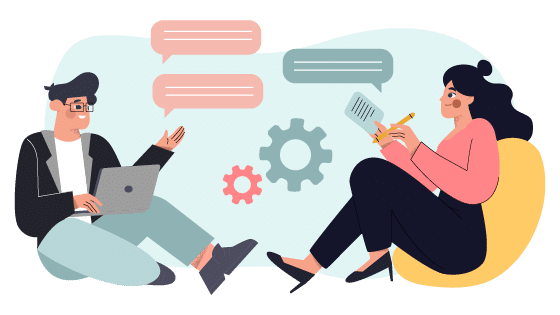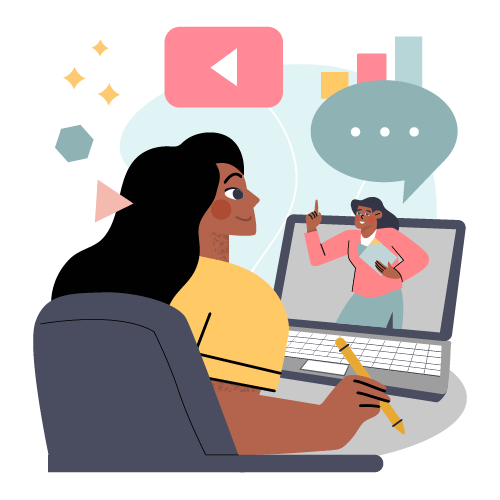“A map tells you where you’ve been, where you are, and where you’re going — in a sense, it’s three tenses in one.”― Peter Greenaway, British Film Director
If maps didn’t exist, we would never get where we wanted to go. The same goes for life. Without plans, we’d never achieve our goals. Maps and plans keep us from wandering around in the weeds. At ELM, we create plans for our customers so they can achieve both their learning objectives and business goals—what we call learning experience maps.
In this blog, we’ll offer the broad strokes in formulating a high-level strategy of your own, to get your training where you want it to go–right into the hearts and minds of your learners!
Understanding Top Leadership Mindset
To understand why a learning map is critical to the success of an organization, we must first appreciate how upper management thinks. Historically, upper-echelon leadership in organizations has always had a different mindset than L&D leaders. Their focus has primarily been on strategic direction – as it should. Critical metrics, on their agenda, that move the organization forward, include:
- Competitive advantage
- Market share
- Shareholder value
- Product and service differentiation
- Return on Investment
- Share price/performance
The Boards of Directors of most private and publicly-traded companies usually hold top-level leadership to account for meeting these metrics. An executive’s career path, compensation, and benefits packages (including stock options and bonuses) are often tied to their achievements of these business goals and operational milestones.
Consequently, but understandably, org leaders spend a lot of time and investment building, evaluating, and monitoring product development road maps. They draw-up battle plans to expand market share. They have teams of experts working on product and service position road maps – even well into Gen3 or Gen5 of their core product or service offerings. However, readers will notice that there’s no mention of training or learning objectives listed in those priorities:
- …even though it is through targeted and competency-specific employee training, that organization will achieve its competitive advantage;
- …and that product and service differentiation only happens as a result of a well-trained, innovative, workforce;
- …or that only trained and skilled employees are better able to defend their market share, and even grab a share of the market from competitors
Historically, according to global consulting firm McKinsey, even when (if) training did become a measurable milestone for an organization, it was more as a means of counting the number of employees who attended or completed a course. Over time, that leadership attitude has changed. A business leadership survey found that:
“75-80% of managers believe effective training is critical to project success, skill levels linked to business value yield a 10% increase in productivity”
If the results of that IBM survey, conducted over a decade ago, are accurate (and there’s no denying that they are!), the tide may have started changing back then, with business leaders beginning to see training objectives and business goals as two sides of the same coin. Still, business leaders continue to not see training as a strategic corporate initiative, worthy of similar planning, road mapping, and funding, as core products and services.
What’s all this talk about learning outcomes and business goals? In our previous blog, we discussed a shift within the eLearning industry. As the “same coin, different sides” realization sinks in, more and more, L&D professionals are being tasked with achieving both, which can be unfamiliar territory.
Push for a Learning Experience Map
Here’s what typically happens…
When leadership comes to the L&D team with a task, for example, we need training on X, NOW, many teams start scrambling. Under tight deadlines and minuscule budgets, most L&D professionals become order-takers. We put our heads down and crank out the training. There’s no time to stop and think about where we want to go and why. Under this kind of pressure, it’s easy to not even think about the business goals. Why do we need training on X and what do we hope to achieve as a result? Will training on X get us there?
It’s time to break a bad habit in the L&D industry. L&D professionals need to push back against assumptions before the organization spends time and money developing training that may or may not be successful or even necessary. Ask this question: What are the business goals and why does leadership think that they will be met with these particular learning outcomes?
In designing a requested training program, L&D teams routinely start with desired learning outcomes. They then work back and frame specific learning objectives to meet each of those outcomes. At the center of those two milestones (objectives and outcomes) however, is a training needs analysis – TNA. Here’s how learning leaders must gently push back on leadership, and ask them to justify that need:
Is there a need for providing training on X, to accomplish the stated business goals; and what ideal learning outcomes can we deliver to support those goals?
In seeking answers to these questions, L&D teams address both sides of that proverbial coin – the business side, as well as the training aspect of it. Unfortunately, “happy outcomes” don’t just happen through a Q&A session. It takes a comprehensive learning strategy, that maps learning outcomes to business objectives, to achieve those goals.
At one organization, this is exactly what happened—and the result, which we will talk about later, was amazing. Leadership saw that users were not adopting a scoping tool and hypothesized that they either didn’t know how to use it or didn’t know it was available. They asked the L&D team to design an entire how-to training for the tool. The L&D team paused before taking that tall order. Rather than putting their heads down and designing a massive course for the tool, they reached out to ELM for a learning strategy design.
Learning Experience Maps 101: Understanding the building blocks
To succeed in any endeavor, be it in sports, business and finance, or delivering powerful, impactful learning outcomes in support of business goals, it’s important to have measurable game plans. Linking individual outcomes to specific objectives, and mapping them to overall goals, is the only way to achieve success in any arena.
Though the process of mapping learning outcomes and business goals is “involved”, the basic building blocks are rather straightforward and logical:
- Look around: If you’re lost on a hiking trip or when driving cross-country, the first thing you do, to get your bearings, is look around you: Where are you now? It’s the same when building your learning map – conduct a State of the Union assessment first, before mapping a course forward.
- Look back: As is the case when trying to get back on course during your hike or road trip, mapping learning objectives and outcomes require understanding how you got to where you are at. A deep introspective look back will reveal learning milestones you missed, as well as offer insights into new routes (learning outcomes) that will get you to where you must go (business goals).
- Look ahead: Finally, these retrospective and introspective assessments of your current learning strategy will then help you develop a comprehensive learning map linking learning objectives, through targeted outcomes, to your business goals.
Famous American baseball icon Yogi Berra once said: If you don’t know where you’re going, how will you know when you get there? Legendary management consultant and business thinker and speaker Peter Drucker has his own spin on Berra’s quote: “You can’t improve what you don’t measure.”. Both sayings provide us the necessary insight to understanding the building blocks required for putting a solid learning map in place, that supports org-wide business objectives.
In the remainder of this post, we’ll dissect each of those three building blocks in greater detail.
Define Where You Really Are
Before you come up with a new hypothesis, you need a very broad overview of your current problem. Think critically about what’s been done in the past. Maybe some methods have worked, and others not so much, but at this point, it’s time to get real.
What we find is that most teams approach problems/solutions in one of three ways: overly positive, overly negative, or somewhere in the middle. You will need to take a candid assessment of your own team and where you fall on the spectrum.
At ELM, that middle ground is the sweet spot—what we call hopeful validation. Hopeful validation is a realistic assessment, tempered with a positive view of the future. It sounds like this: “We have a problem, but there is a solution and we will find it.”
In this state of hopeful validation, try this exercise: Stop, Start, Continue. Here’s how it works: Talk about what’s not working and how to Stop doing that; analyze what is working, and how to Continue doing that, and; determine what you think you need to Start doing and do it.
Discuss Where You’ve Been
When the learning team that we mentioned reached out to ELM, we tested their leadership’s hypothesis by asking the end users questions in discovery. We found the hypothesis was off the mark. Employees weren’t using the scoping tool because it was missing valuable components, which made their jobs cumbersome by adding extra steps!
When you are in discovery, you do a deep current state analysis. By intimately getting to know the business, defining your learning culture, and understanding your learners; you can get a clear picture of the real problem.
Start by asking questions of your key performers, who are the learners doing the process. They help you understand the biggest challenges, missteps, and best practices for performance optimization. Then talk to the subject matter experts (SMEs), who own the process. They help you understand the process steps and how to perform them. You need input from both to do proper discovery.
Decide Where You Want to Go
Once ELM knew what the real problem was with end-users and the scoping tool, creating a Learning Experience Map was easy. By fixing the scoping tool and adding a few new components, employees were thrilled with the tool, as it made their jobs easier. The L&D team was happy because user adoption was off the charts. The leadership was pleased because they saved time and money, while still achieving their business objectives.
While this blog just touches on how to create your own Learning Experience Map, these first few steps will get you headed in the right direction. The point is that you start looking at things from multiple perspectives.
Learning Experience Mapping is a design-thinking approach to meeting both business objectives and learning outcomes. By taking a pause, challenging assumptions, and formulating an educated hypothesis, taking the time to map out where you want to end up will save time, resources, and money.
Map Your Learning Outcomes and Business Objectives
Hopefully, this post has provided you with the building blocks to start building your own learning map. Even though you may have an existing strategy in place, that defines your learning objectives, it might not be effectively mapped to your business goals. And, how does mapping those two aspects help your organization? Well, it:
- Improves performance;
- Spurs productivity;
- Attracts and retains top industry talent;
- Enhances employee engagement across the organization;
- Increases customer satisfaction;
- Develops deeper pools of potential leadership and talent; and
- Fuels a drive for innovation
Most importantly, because your learning map evolves as your business goals change, the mapping process helps to create a culture of continuous learning across the company. That, in itself, is a critical driver of org-wide performance and competitiveness a critical success factor that most business leaders are constantly measured against.
It’s never too late to start mapping your own learning outcomes in support of your business objectives. For a more in-depth look at this topic, take a look at our free webinar and eBook!






